Guinea Pigs are wonderful little animals and can be a joyful addition to any family. They are not, however, starter pets as so many believe. Piggies require specialized veterinary care, at least 10 square feet of living space, a carefully managed diet and regular grooming.
Please review the info below to learn more!
Medications and Supplements
We recommend that your new babies start liquid supplements (Child’s Life vitamin C) from a syringe. Think of this as the multivitamin you take! Since guinea pigs cannot make their own vitamin C (just like humans), they can become very ill if they do not get it from outside sources.
Other great sources of vitamin C are bell peppers, which can be fed daily, and Oxbox vitamin C cookies. Oxbow also makes wonderful cookie supplements for joint health, uriniary tract health and an overall multivitamin. Speak to your vet about adding these other options.
Feeding
Pellets: ¼ cup of timothy based pellets per day/per pig it recommended for adults. Pregnant piggies or those under 6 months can eat pellets with alfalfa. Be sure to avoid pellets that have “colored” bits as these are not healthy for pigs! We recommend the oxbow brand.
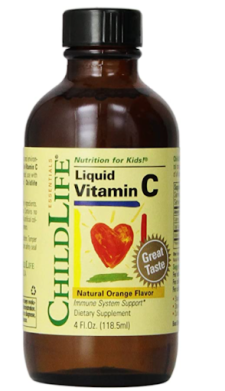

Hay: Unlimited timothy or timothy/orchard mix daily. Alfalfa can be offered to pregnant piggies or those under 6 months. We recommend the oxbow brand. If allergies are an issue in your home, other hay options are available. Consult with your vet on the best options. Hay should make up 80% of your piggie’s diet and helps to prevent overgrown teeth!
We do not suggest metal or plastic hay racks, for both safety and mental stimulation. We recommend Guinea Dad hay boxes in combination with loose hay in a litter box for happy pigs!
Veggies: 1 cup of fresh veggies daily, with those high in calcium and sugar fed only a few times a week. Here at the rescue, we feed our piggies twice daily (AM and PM) and divide the cup between the two meals. We find this helps reduce loose poops and the pigs love it! Lower calcium veggies (at least one leafy green) should be used as a daily base, with higher items mixed in 1-3 times a week. High sugar items like carrots, tomatoes and fruit should be an every once in a while treat. Bell peppers are a great sources of vitamin C and should be offered every day.
Grooming
Guinea pigs will need their nails cut at least every 6 weeks. This can be done with a speciality clipper, a human nail clipper or many vets will do this service for a fee. When the Guinea Pig has light colored nails, you can see the “quick” which will appear as a pink or red area near the toe. This is a blood vessel and should not be cut!
Review this video for more info:
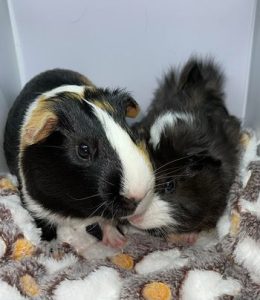
Guinea pigs also might require baths but they do not need them as often as you or your dogs and cats. Most guinea pigs will not need a bath unless they are ill (directed by a vet) or very dirty. Many people will bath their guinea pig quarterly as preventative treatment for ringworm. You can purchase special anti fungal shampoo from pet suppliers, or use non-scent head and shoulders. Just be sure non gets in their eyes or mouth!
Guinea Pigs can get very cold very fast, so after the bath try blow drying them on low/low heat to take the chill out and hold them in a towel until they dry.
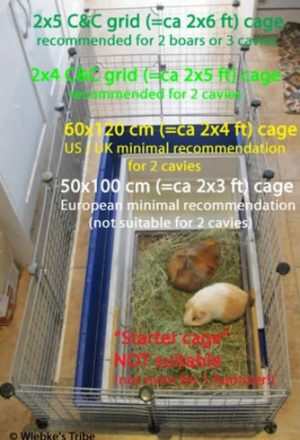
Living Space/Cages
We require a minimum of 10 square feet of horizontal living space for your piggies (for each single or pair), with additional space required for more herd members. This equates to a 2X4 c&c cage (or same dimension diy) for a pair of females and a 2X5 (or same dimension diy) for a pair of males.
See the chart below for an idea of minimum sizing for herds of more than 2 (note: our rescue does not allow the minimums listed on the chat below. We required the sizing under “preferred”):
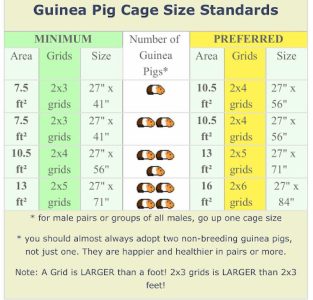
Keep in mind that the required space would be in addition to any loft or upstairs areas (those are not considered part of the horizontal floor space). Ramps should be no more than a 40 degree incline and should have sides. Guineapigcagestore.com sells some great options.
Bedding and Accessories
Guinea pigs can live on a number of healthy bedding options, but some advertised as safe in pet stores might hurt your new friends. We recommend CareFresh paper bedding or fleece bedding. Pine shavings can also be used, but it MUST be kiln dried. We recommend either fleece “flippers” with uhaul pads from etsy markets or Guineadad fleece if you prefer using fleece options.

Guinea pigs need hides to feel safe and should have one guinea safe hide per piggy. Some options are wooden arches, pig-safe wooden castles and fleece beds with covers.
They also enjoy toys that allow them to chew including guinea safe wooden toys and timothy hay based toys. Be sure any wood is pig safe and kiln dried!
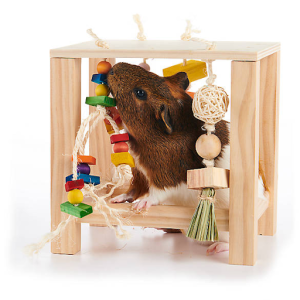
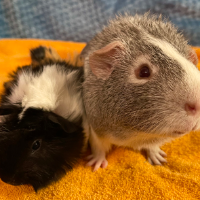
Bonding
If you are planning to house your new babies with other pigs, please be aware that guinea pigs need to be BONDED. Bonding is required for both male and female cage mates and will include some dominance behavior in both sexes.
Pigs should only live in one of the optimal groupings listed below:
- Male pair (2)
- Female pair (2), trio (3) or herd (with appropriate space and care)
- Herd with a single male and 2 or more females
.
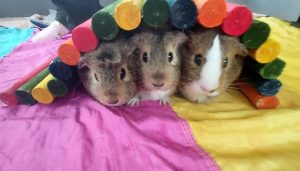
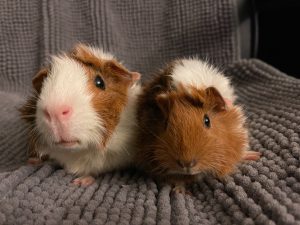
Guinea pigs, especially males, can fight during bonding and will need to be separated. Please be sure to have a towel or wrap around your hand and NEVER put a bare hand in between fighting pigs! Bites hurt and can become infected!
If you see the following behaviors, it is time to separate and the pair/group may not be able to live together:
- Serious and prolonged teeth chattering
- Lunging and biting, especially that draws blood or pulls out hair
- Nosing off with mouth open to show teeth (in combo with above)
Please feel free to reach out with any questions you might have. We are always here to help! We also highly suggest Scotty’s Animals and LA Guinea Pig Rescue youtube channels for more great piggie info!
